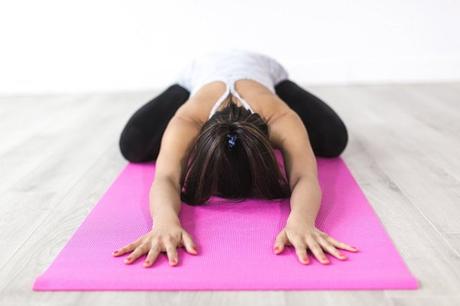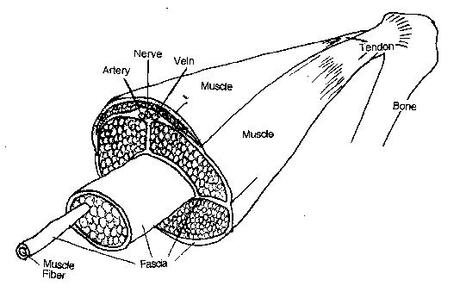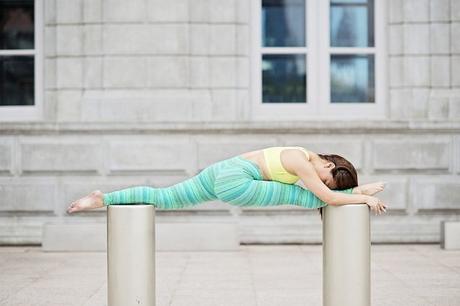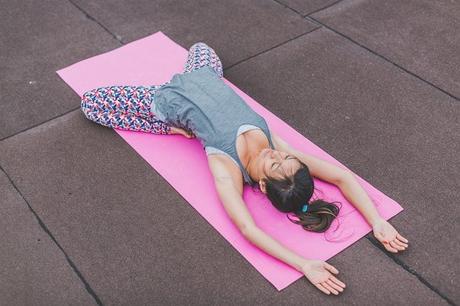
From a reader in Beijing: “I wondered if you might know the difference between stretching muscle and stretching fascia. This is a concept promoted by Paul Grilley’s Yin Yoga series. I wondered if there’s any medical explanation for why stretching fascia is beneficial.
I couldn’t really find anything on the net – it just seems to be an accepted given that holding stretches for 4+ minutes gets into the fascia, and that improves flexibility more than the stretching of muscle. I like your methodical explanations and wondered if you might have an idea?”
Really good questions!
- What’s the difference between stretching muscle and stretching fascia?
- Does holding a stretch for a longer period of time primarily affect fascia?
- Why is stretching fascia beneficial?
Since she’s asked, I’m going to give a very methodical and detailed explanation of just what happens when we stretch, especially when we hold a stretch for a prolonged period of time. I like to hold some asanas for several minutes to facilitate a meditative state and “go deeper” into the posture, and I believe that was the point of their practice – a belief supported by reading the traditional yogic texts written centuries ago.

What are you actually stretching?
It’s difficult to sort out exactly what it is we are lengthening when we go into a pose, but we all know something happens. The longer we reach for our toes, the more we stretch and the easier it is to grasp them.
What we’ve learned through science is that it isn’t just one thing that happens. Stretching is actually pretty dang complicated. Let’s first look at the anatomy of muscle and connective tissue so we can understand what it is we’re talking about. Here’s a nice, simple drawing I borrowed from the folks at Self Care for RSI.

From the drawing you can see that each muscle fiber is wrapped up in fascia, a material a little like the plastic wrap you could see surrounding a leftover chicken leg in the fridge. Each individual muscle fiber wrapped up in its fascia is then collected into a group with another coating of fascia holding the group together.
Then several of those groups of muscle fibers wrapped up in their collective layer of fascia are bundled together in one big group of muscle surrounded by a bigger, thicker layer of fascia.
As the muscle nears a bone, it thins and becomes tapered. The fascia covering each fiber as well as that surrounding the groups of fibers continues and becomes a tendon that forms the connection of muscle to bone.
Scientists call this entire structure the muscle-tendon complex. It’s considered one unit, because as we’ve just learned muscle and fascia are so intimately connected and intertwined that studying only one or the other is difficult. Having said that, we can try to tease out what is happening to each of them when we stretch.
The muscle releases into a stretch because: Stretching muscle causes a reflex mechanism in the spinal cord– sort of like the reflex a doctor elicits when she taps your knee and your leg jerks. Sensitive receptors known as muscle spindles are located throughout the length of the muscle. Muscle spindles note a change in muscle length during a stretch as well as how fast the stretch has occurred.
They send this information to the spine. That triggers the stretch reflex which attempts to resist the change in muscle length by causing the stretched muscle to contract.
The more sudden the change in muscle length, the stronger the muscle contractions will be. (And that is why you want to go slowly into a stretch without any rapid sudden movement.) This reflex helps to maintain muscle tone and upright posture and to protect the body from injury.
The longer you hold an asana and stretch the muscle, the less the muscle spindles can do their job. They only work for a short while. After time, their effect goes away. When that happens, you get a little more length during the stretch because the muscle stops contracting.
There’s another reflex mechanism involving sensory receptors called golgi tendons which lie at the tapered ends of muscles where the tendon is forming from the fascia. These sensors are activated when a muscle is stretched a little farther. Their job is to send information to the spinal cord to elicit muscle relaxation to prevent excessive strain and subsequent injury.
Hundreds of sarcomeres make up each individual muscle fiber. They are divided into bands composed of either actin or myosin. During contraction of a muscle, those bands slide over one another causing the muscle to shorten. The actin and myosin bands are connected to each other by chemical bonds. Stretching causing some of those bonds to break allowing the muscle to lengthen.

Sarcomeres are also elastic. Over half of each sarcomere is composed of a protein called titin that gives it elasticity. Titin acts like a rubber band. It has the ability to increase the length of a muscle when stretched and then to shorten to the original length when the stretch is released.
First its overall shape changes to become elongated and then with increasing force of a stretch, the protein unfolds from its three dimensional structure. The result is a lengthened sarcomere and therefore a longer muscle.
Connective tissue (fascia and tendon) also releases into a stretch. More than half of an initial change in length, the give of releasing into a stretch, is due to elasticity of the connective tissue. There’s a rubber band-like component to it.
In addition to its elastic component, connective tissue creeps with longer duration stretches. That is, stretching for a few minutes causes a reorientation of the collagen fibers within it to a more ordered array. They line themselves up in parallel to provide more lengthening.
Outer tendon fibers are pretty much already in parallel to one another, but the fascia fibers are generally more willy-nilly. Therefore, most of the creep is likely due to changes in the fascia rather than its confluence at the outer tendon.
Creep is what gives connective tissue its ability to maintain length, and therefore flexibility, over the long term. It’s been noted to continue lengthening at time frames of up to one hour. In fact, in one experiment, one-third of the lengthening from a stretch took place during the latter part of the hour.
A decreased perception of pain contributes to increased flexibility. The mind plays a role here. Some researches believe that much of our ability to lengthen muscle-tendon complexes and to increase flexibility comes from our brains’ ability to alter how we feel in response to the stretch.Usually our stretches are stopped by a sensation of discomfort or even, when the stretch is forced beyond that point, outright pain. Over time the exact point at which a stretch makes us feel uncomfortable may tend to increase over a period of repeated stretching exercises.

In other words, the maximum amount of stretch we could tolerate last week might be much less that we can tolerate today because our mind simply doesn’t act to stop the stretch because of a perception of pain.
Pain is a protective response. We quickly pull our hand away from a burner because the brain knows that a burn that will destroy our tissue.
Maybe the brain actually “learns” that a stretch to a certain point is ultimately not harmful and so it has figured out that stretching to that point is okay and it no longer elicits a sensation of “ouch.”
Does holding a stretch for a longer period of time primarily affect fascia?
Yes. At least as far as science can tease out at this point. All those other stretch mechanisms occur first. Then, with time, the creep of connective tissue begins. It seems that creep is primarily from fascia as it the fascia which has more willy-nilly collagen fibers than other connective tissue within the muscle-tendon complex.
Those fascial sheets of plastic wrap-like covering of muscles are in disarray compared to their confluence into tendons located between the muscle and bone. The fibers begin to line up in parallel like lines of soldiers coming to attention. Doing so provides additional lengthening and stretching. It is the more permanent aspect of increased flexibility.
Exactly how long one needs to maintain a stretch to produce creep isn’t clear. It may occur in four or five minutes. By ten minutes it is more likely to be happening. As noted, one research paper reported a continued increase in the creep effect during the latter part of a one-hour stretch.
Why is stretching fascia beneficial?
Stretching connective tissue is the primary way to increase the range of motion of joints in a lasting way. While the other stretch mechanisms provide temporary lengthening, it is the creep effect which contributes the most to long lasting flexibility.
Especially for those with a reduced range of motion from disease or an extended period of inactivity, prolonged stretches can greatly improve function. This has been seen clinically with stretches of the rotator cuff and a tendon on the bottom of the foot that often shortens and tightens causing pain and disability. Longer stretches with creep can be very healing in this regard.
There’s also some evidence that gentle stretching elicits an anti-inflammatory response within the muscle and connective tissue. With more forceful stretches, there’s a counterproductive pro-inflammatory effect. That means long gentle stretches may help to reduce the tendon inflammation of tendonitis.
A bit of caution: Bobbing stretches that are rapid and short can strain the muscles and connective tissue resulting in tears. Don’t bounce. Warm muscles stretch better than cold ones. Temperature can significantly influence flexibility. A five minute warm-up period of general increased activity is wise for best effects and less injury.There may be a relationship between long duration stretches and the maximal amount of force a muscle can provide. If you really need absolute maximum power, longer duration stretches may not be for you.
One group of researches found that a small surgical release of fascia resulted in a 15% reduction in force production due to a lowered compartment pressure. That may translate to a reduced amount of maximum strength after prolonged stretching. Interestingly though, some body builders like to stretch their fascia to make room for greater muscle growth since their concern is bulk and not power.
The bottom line is that longer duration stretches primarily release fascia, and they can significantly improve long-term flexibility and function. Additionally, in my opinion, spending an extended period of time in a stretch in a relaxed manner provides an opportunity for meditation and allows for a deeper level of awareness of the energy body.
You can call it Yin Yoga if you like, but it’s nothing new. When you read the old texts you’ll see that, according to the ancient gurus, it’s the original intention of the Yoga asanas.
References:
- Taylor DC, Brooks DE, and Ryan JB. Viscoelastic characteristics of muscle: passive stretching versus muscular contractions. [Med Sci Sports Exerc 29: 1619-1624, 1997.]
- Janne Avela, Taija Finni, Tuomas Liikavainio, Elina Niemelä, and Paavo V. Komi. Neural and mechanical responses of the triceps surae muscle group after 1 h of repeated fast passive stretches. [Journal of Applied Physiology June 2004 vol. 96 no. 6 2325-2332.]
- Purslow PP. Strain-induced reorientation of an intramuscular connective tissue network: implication for passive muscle elasticity. [J Biomech 22: 21-31, 1989.]
- Herbert RD, Moseley AM, Butler JE, and Gandevia SC. Change in length of relaxed muscle fascicles and tendons with knee and ankle movement in humans. [J Physiol 539: 637-645, 2002.]
- Garfin SR, Tipton CM, Mubarak SJ, Woo SLY, Hargens AR, and Akeson WH. Role of fascia in maintenance of muscle tension and pressure. [J Appl Physiol 51: 317-320, 1981.]
- Paul D Gaspar1 and F Buck Willis2 Adhesive capsulitis and dynamic splinting: a controlled, cohort study. [BMC Musculoskelet Disord. 2009; 10: 111.]
- Yang G, Im HJ, Wang JH. Repetitive mechanical stretching modulates IL-1beta induced COX-2, MMP-1 expression, and PGE2 production in human patellar tendon fibroblasts. Gene.[ 2005 Dec 19;363:166-72. Epub 2005 Oct 13.]
- Thacker SB, Gilchrist J, Stroup DF, Kimsey CD. The impact of stretching on sports injury risk: a systematic review of the literature. [Med Sci Sports Exerc36: 371–378, 2004.]
- Weldon SM, Hill RH. The efficacy of stretching for prevention of exercise-related injury: a systematic review of the literature. [Manual Ther8: 141–150, 2003.]
- Siatras TA, Mittas VP, Mameletzi DN, Vamvakoudis EA. The duration of the inhibitory effects with static stretching on quadriceps peak torque production. [J Strength Cond Res22: 40–46, 2008.]
- Kay AD and Blazevich AJ. Moderate-duration static stretch reduces active and passive plantar flexor moment but not Achilles tendon stiffness or active muscle length. [Journal of Applied Physiology April 2009 vol. 106 no. 4 1249-1256.]

